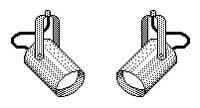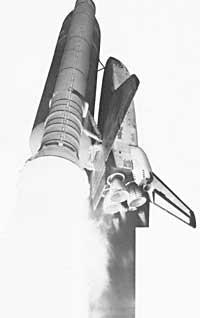Fight the night (I)
1990/10/01 Mujika, Alfontso - Elhuyar Fundazioa Iturria: Elhuyar aldizkaria
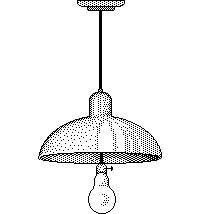
The truth is that the dark of the night, the terror of the night, in everything and in the day to day, we can hardly imagine those who have formed in the era of electric lighting, nor those who knew gas lighting decades ago. Rarely, in the middle of the night, when a lightning or a fault gives off from the claws of Iberduero, in this case we should say of the threads, in which drawer the old candle was kept, or surely that skylight with exhausted batteries left us a ray when we started to pull, when we opened the windows and we do not see streetlights, only then we can reflect on some of the nights.
Also, every day, when we press the switch located on any of the walls adjacent to any of the houses or buildings with an unnoticed hand and illuminate the room, office, room, etc., we never remember the long road traveled by science and technology to get to it.
Origin of artificial lighting: fire
The story of artificial lighting begins with the discovery of fire. At the moment it is not very clear when that happened. However, we know that in the upper Palaeolithic, about 40,000 years ago, the men of Cro-Magnon used fire.
Fire is both a source of light and heat. In the Paleolithic, wood and bones were fuels for fire. The man needed light to reach and live to the bottom of the coats; he found a way to transport the fire through a branch. Juniper branches were used that burn with intense light and little smoke taking off.
Torches and oil lamps
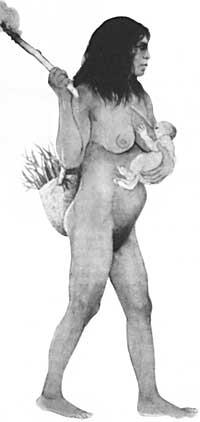
The first improvement was rubbing the branch with resin. Thus the torches were born. The next step would be to stabilize this light source to make it more comfortable and sustainable. Change of fuel, use of fats and oils. By pouring oil into a container and inserting a mucosa or wick (wick formed by a bundle of capillary tubes, such as cotton threads), the oil rises by capillarity above the mucus. By burning the end of the mucus and reacting with oxygen in the air, the flame temperature burns fat. Thus the lamp of oil or lamp was born.
In the oil lamp, the mission of the mucosa is to bring the amount of fuel needed evenly to the flame. But to achieve this, being the fixed mucosa, it is necessary to keep the oil level fixed in the container. If the oil level drops, the light intensity will decrease and eventually turn off. To avoid this problem, in some lamps the mucus floats on the fuel, moving with the oil level and stabilizing the light intensity.
Neolithic (5000-2500 BC) used pottery to make lamps. Stone, bronze and fermentation were also used for the manufacture of lamps. Phoenicians, Egyptians, Greeks and Romans developed very fine oil lamps, carved and decorated, which were originally a mere instrument, becoming decorative elements.
During the millennium, torches and oil lamps were the only instruments that humanity used against the night.
Appearance of public lighting
It may be thought that in ancient times public lighting was hardly used. In Athens, for example, there was no light in the streets. The lamps were only placed in the streets where there were brothels; not to illuminate the street, of course, but to indicate where the brothels were. Only at parties the streets were illuminated by rows of torches.
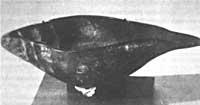
In the early days of Rome, in the streets there were only lighthouses on the doors of the brothels. Those who were going out into the street at night had to wear torches or lighthouses. The rich Romans had a servant named lanternarius to carry the lantern through the streets. Subsequently, several main streets are gradually illuminated, especially in the big parties. Caligula was the first emperor to illuminate all of Rome during the night games. We cannot forget Emperor Nero in this story we are telling. And the famous Nero is owed a terrible “technological advance”, but the innovation is enormous: he invented human torches. The Christian rubbed with resin and burned them alive as a spectacle.
II. In the twentieth century, the Romans began to use a candle of chelesque origin, made of lamb. Sailing is one more step towards the oil lamp (fuel is solid giving access to solid fats in this story: billiards and wax. For example, lamb candles lit the streets of Antioch IV. In the 20th century.
For many centuries wax candles were used exclusively by great kings, princes and commanders of the Church, for their high price. For example – making a big leap in our history – at the time of the Louis XVI, the nobility used wax candles to illuminate the rooms of the palaces during the night holidays. In the big feasts fifteen thousand or more candles were burned and the waiters of the palace, when the next day the rooms were cleaned, collected all the remains of candles for later sale, so the money collected them day enough to enjoy a quiet retirement.
Throughout the Middle Ages, as well as at the beginning of the Renaissance, no progress was made, both in public and private lighting. Public lighting was even scarcer than in the Roman Empire. Since sunset the only information for those who were going out on the streets was the light on the right, except for the lamps of several towers.
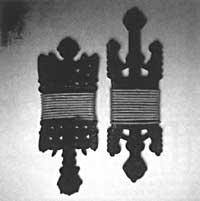
The French king Louis XIV gave Paris public lighting. To do this, he installed luminaires in the center of each street and at both ends. The Argiontzians came down and went up with a rope attached to the wall, and only used in the winter zone. Later, Louis XVI extended public lighting to cities throughout France, establishing a new tax covering its cost.
XVIII. News from the century
XVIII. In the 18th century many inventors tried to solve the problem of street lighting. In 1769, Bourgeois de Chateaubriand invented a special electrician (who did not produce shadows under him by means of a reflector or reflector) that was implanted in certain areas, but it was not very comfortable: in order to light it had to go down to the height of the wax, clean it, discard the reflective screen and fill the container with oil, all in the middle of the street and hindering traffic. However, this system is the XIX. It remained until the beginning of the 20th century.
Later, around 1820, the paraffin candle appeared and then, thanks to the work of Eugene Chevreul, began to produce stearin; since then the candles are made with stearin, which burns much better than the fats that until then were used.
Liquid fuel lamps developed rapidly in the 18th century. At the end of the 20th century. In the old lamps the mucus was cylindrical and full, the oil rose in excess, burning a lot of fuel, but with oxygen deficit, that is, the combustion was not good. When combustion occurs in these conditions, the flame is red, much smoke is emitted and the gases and vapors that escape the flame without burning stain the air of the room, preventing breathing. Therefore, the first improvement was to change the shape of the mucus. The use of smooth, flattened mucus increases the flame surface thus improving combustion.
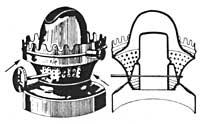
In 1784, physicist Aimé Argand invented a double current air lamp, but French pharmacist Antoine Quinquet made a small improvement to Argand's lamp and gave it its name, which we all know. Argand, worried about Quinquet's theft, went crazy. The Argand lamp has a cylindrical mucus built and is located inside a glass fireplace. It is better than a muki laune lamp, after all air not only surrounds a flame outside, but also inside. Consequently, the gases produced by the fuel are completely burned.
In 1800, Bertrand Guillaume Carcel invented a lamp with a constant oil level on the burner (Carcel lamp), stabilizing the light intensity of the lamp. A clockwork pump sends the oil from the oil tank at the foot of the lamp to the burner, returning the excess shipping from an overflow to the container. Other more sophisticated lamps were also invented to keep the oil level constant (see in the figure the operation of the lamp called “Moderator”).
Oil also replaced oil, which is absorbed with capillarity more easily than oil. By burning oil gases at a much lower temperature than oil, you need a stronger, well-regulated air stream for good combustion. When these conditions are met, oil does not generate any smoke. In these lamps, the oil tank is usually relatively far from the burner to avoid heating.
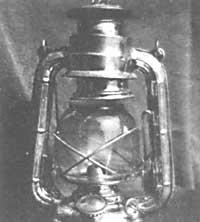
In 1870 the oil lamp was used throughout the civilized world, among other things because it was quite cheaper compared to other fuels, such as wax, oil. The quinque was the most used oil lamp, but many other types of lamps were also developed
In addition to oil, they were used as benzin fuel and volatile oils, but they are dangerous. Special lamps were needed for these fuels, since conventional fuels would have exploded. Volatile oils can be burned in lamps without mucos.Oil evaporates before reaching the flame, that is, steam or gas is the one that burns in the flame.
XIII. In the 19th century, public lighting for liquid fuels spread to European cities and in the 19th century. It lasted until the mid-twentieth century. However, XIX. The fight against the night in the early twentieth century was a great impulse with a novelty: the gas of lighting. In the next issue we will have detailed news.
Cutting and details of the lamp called “moderator”
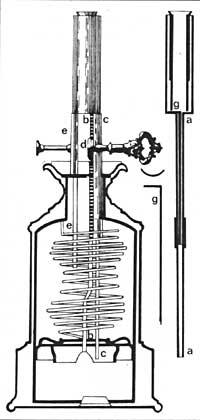
Operation: the oil container of the lamp is made of sheet metal and the bottom is mobile, being able to be raised by BB zipper and D gear wheel. A spiral spring resists the movement of the bottom and compresses when climbing the bottom. If with the low moving bottom the oil is poured into the lamp, it stays on top, but if we drive the wheel D and raise the bottom, the oil will pass to the other side of the moving bottom by the depression that is generated below. The leather strip with moving bottom behaves like a valve, letting the oil go down and preventing it from coming up. By withstanding the spring pressure and not being able to pass to the top of the container (the valve prevents it), the oil ascends through tube C. This tube (see detail) consists of two AA pipes, the smaller diameter is welded to the moving bottom and can slide within a larger diameter.
When the moving bottom is at the top of the container and therefore the pressure of the spring is higher, the moderator needle G occupies the entire inner part of tube A of smaller diameter and makes it difficult for the oil to go up the tube to the burner. As spring pressure decreases, the part of the G moderator needle that is inserted into tube A will also become shorter. Thus, the reduction of the pressure that drives the oil upwards is compensated by the decrease in the resistance that the oil finds to rise. The excess oil is nailed to the oil by pipe E.
Cautius lamp. Cutting and burner detail
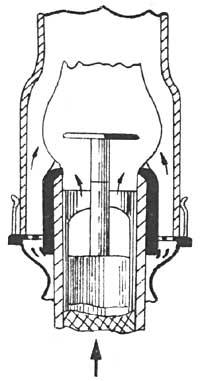
Operation: the mucus is cylindrical (Argand burner), in which the flame protrudes only inside the mucosa, since the upper edge of the mucus is covered by a fold or fold of the tube to which the mucosa holds. This arrangement achieves a better mixture of air gases and air heating, increasing the flame temperature. A concentric tube with the mucus support tube sends air through the outside of the flame.
The air also has access from the inside of the mucus. On the upper end of the inner tube of the cylindrical mucus is a horizontal disc. Against it is directed the internal ascending air stream of the mucus, taking an internal radial direction out and pushing the flame out. With this burner a white-white flame is obtained and the mucus is not charred. The height of the flame, and therefore the light intensity, can be regulated by the lever c; if the tube rises to point b, the lamp turns off. The lamp oil tanker is made of metal and is filled by the point and even if the lamp is lit.

Gai honi buruzko eduki gehiago
Elhuyarrek garatutako teknologia



